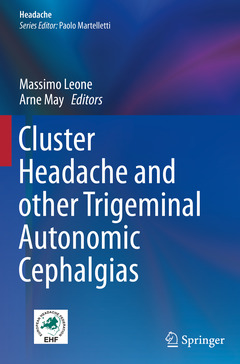Cluster Headache and other Trigeminal Autonomic Cephalgias, 1st ed. 2020 Headache Series
Coordonnateurs : Leone Massimo, May Arne

This book provides essential insights into the current state of knowledge regarding the main aspects of cluster headache and trigeminal autonomic cephalgias. The first chapters focus on classification and clinical features, together with familial and genetic aspects. Relevant animal models and the putative role of key nervous structures as the hypothalamus, brainstem, diencephalon and sphenopalatine ganglion are reviewed. Evidence gained from key molecules such as CGRP in animals and human headache models are discussed.
The book subsequently presents information on the various aspects of the pathophysiology of trigeminal autonomic cephalalgias for example regarding the implication of the trigeminovascular system and the facial autonomic reflexes of the brainstem. Further, it shares insights from imaging studies including functional magnetic resonance imaging and more advanced techniques, as well as brain stimulation procedures. Further chapters describe the current st
ate of knowledge concerning drug treatment and the various neurostimulation procedures. Trigeminal neuralgia is also presented, due its close relationship with some short-term trigeminal autonomic cephalgias: a great deal can be learned from a better understanding of their differences and similarities. The same approach is then applied to cluster headache and migraine.All chapters were written by respected experts in their fields, ensuring the book will provide an excellent source of up-to-date information and perspectives on trigeminal autonomic cephalgias and related disorders. As such, it will be of considerable value for students, clinicians and pain researchers alike.
1 History and Epidemiology.- 2 Classification and clinical features.- 3 Differential diagnosis including secondary forms and headache forms in chapter 4 of the IHS classification.- 4 Genetics of cluster headache and related disorders.- 5 Pathophysiology of trigeminal autonomic cephalalgias.- 6 Neuroimaging.- 7 The nature of pain in trigeminal autonomic cephalgias: neuropathic? Nociceptive?.- 8 What role for the hypothalamus and diencephalic area.- 9 Animals models for trigeminal autonomic cephalalgias.- 10 CGRP: from headache mechanisms to monoclonal antibodies.- 11 The sphenopalatine ganglion: new insights.- 12 Pharmacological treatment.- 13 Neurostimulation: why, when, which one.- 14 Behavioral and psychological aspects.- 15 Neurophysiology.- 16 Indomethacin and trigeminal autonomic cephalalgias.- 17 Trigeminal neuralgia: channels, pathophysiology and therapeutic challenges.- 18 Maybe this one: Neurovascular headaches: migraine and cluster headache pathophysiology, differences and similarities.
Arne May is a Professor of Neurology at the Department of Systems Neuroscience, University of Hamburg and head of the headache outpatient clinic and the facial outpatient clinic of the University Clinic of Hamburg. His major research interests are the basic mechanisms of facial and head pain, the chronification of pain and plasticity within the human brain. His group’s work involves humanimaging studies in primary headache as well as experimental studies of trigeminovascular nociception, with the aim of understanding how to modulate facial and headache syndromes and chronicity of pain. Prior to his position at the University of Hamburg, Professor May was a clinician and conducted research on pain and headache syndromes at the University of Regensburg. Prior to this he completed his residency in the Neurology Department of the University of Essen, followed by post-doctorate studies at the Institute of Neurology in London. Professor May has been a member of the Board of Trustees of the International Headache Society since 2013, and has published over 300 original and review articles.
Date de parution : 08-2020
Ouvrage de 264 p.
15.5x23.5 cm
Date de parution : 08-2019
Ouvrage de 264 p.
15.5x23.5 cm



